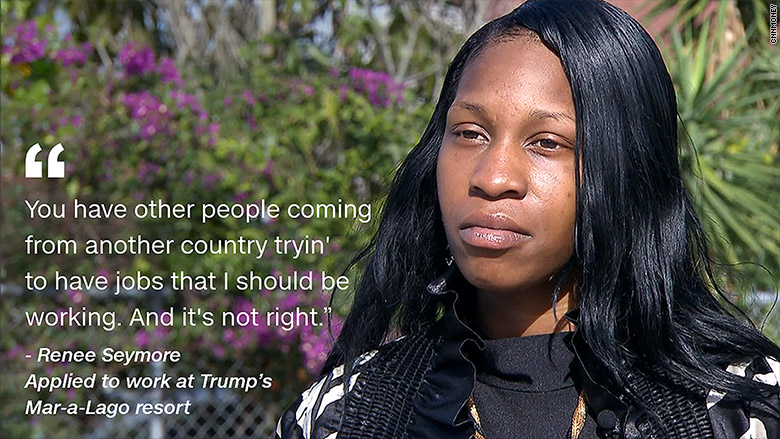
Here's Donald Trump's dilemma: He is running for president on a platform of bringing jobs back to the U.S. and making America Great again.
But at his private club in south Florida, he has filled his staff almost exclusively with imported foreign workers. And he has been doing it for years.
The U.S. Department of Labor has confirmed to CNN that between 2013 and fall 2015, Trump's Mar-a-Lago club posted 250 seasonal job openings and filled just 4 of those jobs with American workers. The club requested the rest of the staff be temporarily imported through the Federal government's H-2B visa process. Basically, Mar-a-Lago brings in its seasonal staff from overseas.
Mar-a-Lago is a mansion that Donald Trump has turned into a members-only private club in Palm Beach, Florida. The wife of New York stockbroker E.F. Hutton built it in 1927. Mrs. Hutton, who would become Marjorie Merriweather Post, used Mar-a-Lago as a winter retreat for her and her wealthy Wall Street friends. Gilded in tile and other decorations, it reeked of the opulence of the pre-Depression roaring 1920s: Think Great Gatsby, flamboyant parties, poolside waiters.
Mar-a-Lago, literally Sea-to-Lake in Spanish, became a National Historic site in 1969. Post passed away in the early 1970s and the mansion was turned over to the federal government to be used as a presidential retreat. It didn't catch on, and was eventually placed on the market.
Trump says he bought Mar-a-Lago in 1985 for $5 million. He then began remodeling the 114-room mansion for use as his personal residence, and in 1995, he opened the home as a club for the super wealthy escaping the harsh winters of the north. Membership fees are $100,000 with annual dues of $14,000. On its website, Mar-a-Lago is called "the greatest mansion ever built."
Mar-A-Lago is seasonal. It's open when it's too cold to play golf in other parts of the country. And it closes when it's too hot to play golf in southern Florida. And that, says Trump, makes it hard to find American workers willing to fill full time service jobs for roughly eight months a year.
Related: What we know about Trump's money
From 2013 to 2015, Mar-a-Lago was approved to hire 246 foreign workers by the U.S. Department of Labor with H-2B visas, which allow U.S. employers to temporarily import foreign workers to fill non-agricultural jobs that can't be filled with Americans.
To get approval for H-2B visas, employers must prove they need extra workers and that they made an effort to recruit domestic workers, contacted everyone who responded to ads and hired all qualified applicants. After receiving approval, employers must petition U.S. Citizenship and Immigration Services to bring foreign, temporary workers into the country.
Trump has made the case that he couldn't find American workers. "It's almost impossible to get help," the Republican presidential candidate told CNN last month. "And part of the reason you can't get American people is they want full time jobs."
That is news to Tom Veenstra. He is senior director of support services at the Palm Beach County CareerSource office. It's a free service that links qualified job candidates with employers. And during the past two years, the agency has placed more than 50,000 people in jobs in Palm Beach County. Veenstra says he has no doubt he could fill Mar-a-Lago with U.S. workers.
"We have hundreds of qualified candidates for jobs like these," Veenstra told CNN. "That's what we do here. We help place local residents into jobs like those."
Did Trump use the free service? Only once, Veenstra says. After criticism about its hiring practices, Mar-a-Lago asked the Palm Beach County CareerSource office to send over qualified candidates for a single position. Veenstra says he sent four applicants, one was hired.
Veenstra says there were no problems with the hire as far as he knows, but they never had another request from Mar-a-Lago.
Mar-a-Lago positions paid roughly $10 an hour for maids and housekeepers going up to $13 an hour for cooks, and about $11 for waiters and waitresses.
Related: Trump University controversy ... in 2 minutes
The Department of Labor requires proof that an employer seeking to import workers tried but failed to attract qualified U.S. workers.
Records show Mar-a-Lago appears to have done the bare minimum required by law. According to a CNN analysis of hundreds of pages of Labor Department documents, Mar-a-Lago did not place advertisements in the area's largest newspaper. Instead, ads were placed in a local paper with a small circulation and the ads were routinely posted for just two days, the minimum required by law.
In addition, employer statements on recruitment reports are self-reported, and federal employees told CNN that the Department of Labor does not have the resources to check the accuracy of them.

Renee Seymore did apply to one of the job postings. She is a 22 year-old with experience as a waitress, and says she told Trump's staff she would have had no problems accepting a seasonal position at Mar-a-Lago. She was never hired. In fact, she says she was never even formally turned down for the job.
After an in-person interview, Seymore waited for a phone call that never came. "No message, no email, no nothin'," she explained to CNN. "I needed that income because I was outta work. Like I told 'em, I don't care if they put me scrubbing a floor. It's money. It's a job."
Trump's campaign has not offered additional comments regarding criticism over the hiring practices at Mar-a-Lago. Instead, Trump has stuck to his explanation on the campaign trail that he could not find U.S. workers who would take the jobs.
Trump will have a hard time convincing at least one Florida waitress. "It hurts," Seymore told CNN. "You have other people coming from another country trying to have jobs that I should be working. And it's not right."
CNN's Will Cadigan contributed to this report.


